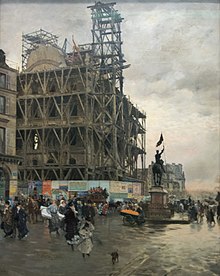Pavillon de Marsan

The Pavillon de Marsan was built in the 1660s as the northern end of the Tuileries Palace in Paris, and reconstructed in the 1870s after the burning down of the Tuileries at the end of the Paris Commune. Following the reunion of the Louvre and the Tuileries in the 1850s and the demolition of the Tuileries' remains in the early 1880s, it is now the northwestern tip of the Louvre Palace. Since 1897 it has been part of the Musée des Arts Décoratifs, a separate institution from the Louvre.
History[]

The pavilion was originally built in 1666 on a design by Louis Le Vau.[1] In the third quarter of the 18th century it included the apartment of Marie Louise de Rohan, governess of the king's grandchildren and known as Madame de Marsan from her past marriage with Gaston, Count of Marsan, from which it took its current name. At the time when the royal family inhabited the Tuileries during the French Revolution, Madame Adélaïde had her apartment on the pavillon's ground floor.[2]
In the 1800s, Percier and Fontaine started the extension of the Pavillon to the east in order to complete the Louvre Palace. But their North Wing, whose southern façade adopted the giant order of the western section of the Grande Galerie, only went as far as the pavillon de Rohan. The reunion of the Tuileries and the Louvre would only be completed a half-century later with Napoleon III's Louvre expansion.
In 1871 the Pavillon de Marsan burned down together with the Tuileries Palace. Its ruins were entirely demolished and the pavillon reconstructed by Hector Lefuel from 1874 to 1879. Lefuel, who disliked the giant order as a matter of principle and found it unsuitable for the Louvre, went on to reconstruct the North Wing on a slightly broadened footprint, but works to that end stopped around the time of his death in 1880.[1] As a consequence, the North Wing is now divided into Lefuel's aile de Marsan to the west and Percier and Fontaine's aile de Rohan to the east.
A project to locate the Cour des Comptes in the pavillon de Marsan was stillborn, even though the building was used in the late 19th century to store archives of that institution.[3] In 1897 the Pavillon and aile de Marsan were eventually attributed to the Union centrale des Arts décoratifs, which remodeled it from 1898 to 1905 under designs by Gaston Redon assisted by Paul Lorain.[4]
Decoration[]
The pavilion is adorned with abundant architectural sculpture, as with other parts of Lefuel's work at the Louvre. An unusual feature is the use of copper for the wings of an allegorical winged lion above the southern pediment facing the Carrousel Garden, created by Théodore-Charles Gruyère in 1878.[5]
See also[]
Notes[]
- ^ Jump up to: a b "Louvre, Paris: the Rohan wing with the Pavillon de Marsan on the far left". RIBA Royal Institute of British Architects.
- ^ Georges Lenotre (1933). Les Tuileries : Fastes et maléfices d’un palais disparu. Paris: Firmin-Didot.
- ^ Michel Goutal (2015). "Diffusion, réception de l'œuvre d'un artisan-entrepreneur : la maison Monduit". Livraisons d'Histoire de l'Architecture.
- ^ "29 mai 1905 : L'inauguration du musée des Arts décoratifs au pavillon de Marsan". MAD.
- ^ "Pavillon Marsan – Paris : Restauration du clos couvert du Pavillon Marsan". Groupe Balas.
Coordinates: 48°51′48″N 2°19′57″E / 48.8634°N 2.3324°E
- Louvre Palace
- Buildings and structures in Paris
- Architecture stubs
